
Unit 4
Signs, Signals, and Road Markings
A. Recognizing traffic signs
Traffic signs, introduction
Traffic signs are devices placed along, beside, or above a highway, roadway, pathway, or other routes to guide, warn, and regulate the flow of traffic, including motor vehicles, bicycles, pedestrians, equestrians, and other travelers.
Traffic signs are used for three different purposes:
(a) to regulate traffic, movement, or parking,
(b) to warn of potential dangers or changes in road conditions, and
(c) to provide information and guidance.

Traffic signs, shapes, introduction
Traffic signs have shapes that denote specific meaning. The shape of the traffic sign allows you to quickly determine whether you are being presented with a regulation, a warning, or information or guidance, and sometimes the specific meaning of the sign.
Traffic signs, shapes, octagon
This shape is used exclusively for stop signs. A driver should be able to immediately recognize that an octagon-shaped sign means STOP.
Traffic signs, shapes, equilateral triangle, point down
This shape is used exclusively for yield signs. A driver should be able to immediately recognize that an equilateral triangle shaped sign pointed down means YIELD to other vehicles and pedestrians.
Traffic signs, shapes, circle
This shape is used exclusively for railroad advance warnings and civil defense evacuation route markers. The most common use in California is for railroad advance warning. A driver should be able to immediately recognize that a sign in the shape of a circle means there is a railroad crossing ahead.
Traffic signs, shapes, crossbuck
This shape is used exclusively to warn of a railroad crossing. A driver should be able to immediately recognize that a sign in the shape of a crossbuck means that there is a railroad crossing ahead.
Traffic signs, shapes, pennant
This shape is used exclusively to indicate a no passing zone. This type of sign is rare in California, but is used in other states. A driver should be able to immediately recognize that a sign in the shape of a pennant means passing is not allowed.
Traffic signs, shapes, pentagon
This shape is used exclusively to indicate a school zone or a school crossing. A driver should be able to immediately recognize that a sign in the shape of a pentagon means that you should watch for children in or around the roadway.
Traffic signs, shapes, diamond
This sign is used exclusively for warning signs (e.g., cross road ahead, end/begin divided road, merging traffic, curves, and construction warning signs). A driver should be able to immediately recognize that a sign in the shape of a diamond indicates that there is a potentially dangerous situation ahead or some change in roadway conditions ahead.
Traffic signs, shapes, vertical rectangle
This shape is used for regulatory (e.g., speed limit, no parking, carpool, and keep right) and sometimes warning (e.g., slow-- children at play) signs. A driver should be able to immediately recognize that a sign in the shape of a vertical rectangle indicates a regulatory or warning action you must obey.
Traffic signs, shapes, square
This shape is used for regulatory (e.g., do not enter, no U turn, no parking, no pedestrian crossing), warning (e.g., advisory speed limit and construction), and guide (camping, and airport) signs.
Traffic signs, shapes, horizontal rectangle
This shape is used for regulatory (e.g., road closed and carpool), warning (e.g., signal or stop ahead), and guide (e.g., rest area ahead and construction) signs.
Traffic signs, shapes, trapezoid
This shape is used for recreational area guide signs (e.g., rest area and tourist information ahead) in some states.
Traffic signs, shapes, other shapes
Various shapes are used for road marker signs (e.g., interstate highway routes and state highway routes).

Traffic signs, colors, introduction
Traffic signs also have colors that denote specific meanings. The color of the traffic sign allows you to quickly determine whether you are being presented with
(a) a regulation,
(b) a warning, or
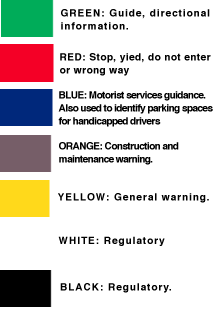
(c) information or guidance.
Traffic signs, colors, red
Red is used exclusively for STOP and YIELD signs, multi-way supplemental plates (e.g., 4-way stop), DO NOT ENTER and WRONG WAY signs, for legend or symbols on certain regulatory signs, and as part of Interstate and certain State route markers.
A red circle with a red line through it is also used to denote that something is not permitted. The picture inside the circle shows what you cannot do.
Traffic signs, colors, black
Black is used as background for ONE WAY, night speed limit (in other states), and inspection station signs, and as message color on signs with white, yellow, or orange backgrounds.
Traffic signs, colors, white
White is used as background for route markers, guide signs, and certain regulatory signs, and as message color on signs with brown, green, blue, black, and red backgrounds.
Traffic signs, colors, orange
Orange is used as background color for construction and maintenance signs.
Traffic signs, colors, yellow
Yellow is used as background color for warning signs (except construction and maintenance signs), and some school signs.
Traffic signs, colors, brown
Brown is used as background color for guide and information signs related to points of recreational or cultural interest and on some street name signs.
Traffic signs, colors, green
Green is used as background color for guide signs, mileposts, and street name signs, and as a message color on permissive regulation and parking signs.
Traffic signs, colors, blue
Blue is used as background color for traveler services information signs, Civil Defense Evacuation Route Markers, and some street name signs.
Traffic signs, colors, fluorescent yellow-green
Fluorescent Yellow-Green is also used as background for pedestrian, bicycle, and school crossing warning signs.
Traffic signs, colors, purple, light blue, and coral
Purple, light blue, and coral have been reserved for future use on road signs.
Traffic signs, regulatory, general
Regulatory signs tell you of important rules that you must obey.
A few of the more important regulatory signs are discussed below.
Traffic signs, regulatory, stop
This sign means that you must make a complete stop before entering a crosswalk, passing the limit line (discussed below), or entering the intersection. If no crosswalk or limit line is marked, you must stop at the corner. You must give the right-of-way to all vehicles and pedestrians who arrived before you at the intersection, or who are currently in the intersection. On divided highways, a STOP sign for crossing or turning vehicles is often placed on the island or dividing strip. You must also stop for these signs. STOP signs are sometimes accompanied by small red multi-way supplemental plates (e.g., all-way and 4-way) which indicate whether other traffic also has a stop sign.
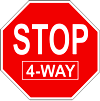
Traffic signs, regulatory, yield
This sign means that you must slow down, be ready to stop, and let other traffic (including pedestrians and bicycles) have the right-of-way before you continue driving.
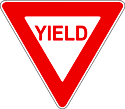
Traffic signs, regulatory, do not enter and wrong way
The DO NOT ENTER sign tells you that there is danger ahead because vehicles will be coming toward you. The WRONG WAY sign tells you that you are traveling the opposite direction of traffic in the lane. These signs are often placed together on freeway offramps. If you see either of these signs, drive to the side of the road and stop. You are going against traffic. When safe, back out or turn around and go back to the road you were originally on.
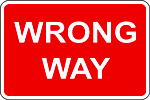
Traffic signs, regulatory, one way
These sign means that traffic on the road travels only in the direction that the arrow is pointing.

Traffic signs, regulatory, parking
Most parking-related signs are also regulatory, meaning that they also must be obeyed. The sign depicted below means that you may not park here.
Traffic signs, warning, general
Warning signs alert you to potential dangers ahead and changes in the road conditions. All warning signs must also be obeyed. A few of the more important warning signs are discussed below.
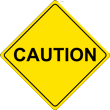
Traffic signs, warning, pedestrian crossing
This warning sign indicates that there may be pedestrians crossing the roadway ahead. You should slow down, look carefully for pedestrians crossing or about to cross the road, and yield the right-of-way to pedestrians crossing.
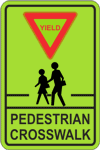
Traffic signs, warning, school zones
A number of warning signs are related to schools and playgrounds. You should slow down and carefully watch for children who might enter or cross the road. Speed signs are often posted along with these signs. These signs must also be obeyed.
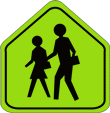
Traffic signs, warning, construction
A number of orange warning signs are related to roadway construction and maintenance. This sign means that you must slowdown and proceed with caution. You should expect construction equipment or workers ahead.
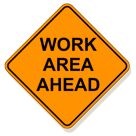
Traffic signs, guide and informational, general
Guide and information signs inform you of services, recreation areas, and destination information.
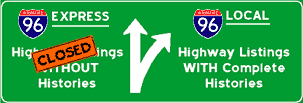
B. Recognizing traffic lights
Traffic lights, introduction
Traffic lights are devices placed along, beside, or above a highway, roadway, or other routes to regulate the flow of traffic, including motor vehicles, bicycles, and pedestrians.
![]()
Traffic lights, position of lights and sequence
The most common type of traffic light has three lenses, although you will occasionally see other designs. The position of the three colored-lenses on most traffic lights is red on top, yellow in the middle, and green on the bottom. The sequence in which they are lighted is green to yellow, yellow to red, and red to green.
Traffic lights, solid red
A solid red light means to stop completely behind limit line, crosswalk, or before entering the intersection. You must wait for a green light to proceed, except as noted below.
Traffic lights, solid red, right turns
A right turn may be made on a solid red light after you have yielded to all traffic and pedestrians and if a NO TURN ON RED sign is not posted.
Traffic lights, solid red, left turns
If there are no signs prohibiting it, you may turn left on a red light if you are both turning from and turning into a one way street, after you yield the right-of-way to pedestrians within the adjacent crosswalk and traffic using the intersection.
Traffic lights, solid yellow
A solid yellow traffic light means that the light will soon change to red. When you see a yellow light, you should slow down and stop before entering the intersection, if you can do so safely.
You should not enter an intersection when the light has changed to yellow, unless you cannot stop safely before doing so. If you must enter an intersection on a yellow light, it is important to watch out for cross traffic and vehicles starting right or left turns that might enter the intersection when the light changes.
Traffic lights, solid green
A green light means that you may proceed straight through or make a turn as noted below after the intersection is cleared of vehicles, bicycles, and pedestrians.
You may make a right, left turn, or U turn on a green light, unless it is prohibited by a sign. However, you must yield the right-of-way to oncoming vehicles and bicycles, and pedestrians crossing the street that are close enough to pose a hazard.
Traffic lights, solid green, gridlock
Do not enter an intersection, even when the light is green, unless there is enough space to completely cross the intersection before the light turns red. If heavy traffic causes you to block cross traffic, you can be cited for causing gridlock.
Gridlock means that traffic at an intersection is so heavy that vehicles are unable to pass through or complete turns. These vehicles become stranded in the middle of the intersection and thereby prevent drivers traveling in the opposite direction from passing through. If you block an intersection, you can be cited.
In order to prevent gridlock, regardless of whether you have the right-of-way, you must not enter an intersection unless traffic conditions will allow you to exit it before the light changes to red.
Traffic lights, red arrow
A red arrow means to stop behind the limit line, crosswalk, or intersection until the green arrow or green signal appears. Horizontal red arrows are used to control traffic in left or right turn lanes. Vertical red arrows are used to control a specific lane of straight-through traffic.
A turn (including a right turn) or other movement cannot be made in the direction of the red arrow, even after stopping first.
Traffic lights, yellow arrow
A yellow arrow means that you should be prepared to obey the next signal that appears, which could be a solid green or red light, or a red arrow. If the yellow arrow is horizontal, it means that your protected turning period (during which all oncoming traffic is stopped by red lights) is about to end. Horizontal yellow arrows are used to control traffic in left or right turn lanes. Vertical yellow arrows are used to control straight-through traffic for a specific lane.
If you cannot stop safely before entering the intersection on a yellow arrow, it is important to watch out for cross traffic and drivers starting right or left turns that might enter the intersection when the light changes.
Traffic lights, green arrow
A green arrow means that you may proceed in the direction that the arrow points (i.e., left, right, or straight), after you yield the right-of-way to any vehicle, bicycle, or pedestrian still in the intersection. Horizontal green arrows are used to control traffic in left or right turn lanes. Vertical green arrows are used to control straight-through traffic in a specific lane.
A horizontal green arrow pointing to the left or right means that you may make a protected turn, which means that all oncoming vehicles, bicycles, and pedestrians are stopped by red lights as long as the green arrow is lighted.
Traffic lights, U-turn only arrow
Arrows in the shape of an upside-down U are sometimes used to control lanes of traffic that may make U turns only. You should obey red, yellow, and green U-turn only arrows in the same way that you would obey horizontal arrows of the same color, except that you may only make a U-turn.
Traffic lights, flashing red
A flashing red signal light has the same meaning as a stop sign. You must stop completely behind the limit line, crosswalk, or intersection and yield the right-of-way to vehicles and pedestrians in the intersection before you proceed.
Traffic signal lights which are malfunctioning will sometimes flash red.
Traffic lights, flashing yellow
A flashing yellow light is a warning to slow down and be especially alert. You do not necessarily have to stop, but you should check traffic both ways at the intersection before proceeding through.
Traffic lights, not working
If all traffic signal lights at an intersection are not working because of an electrical power failure, you must stop at the intersection behind the limit line, crosswalk, or at the corner. A blacked-out traffic signal should be treated the same as a stop sign. You should only proceed when you know that all other turning and approaching vehicles, bicycles, and pedestrians will also be stopping.
Traffic lights, non-intersections
When traffic lights are erected at places other than an intersection (such as a crosswalk in the middle of a block or highway), you must obey the traffic signal. For red lights you must completely stop at the limit line, crosswalk, a special sign, or at the signal itself.
Traffic lights, automated enforcement
Traffic signal automated enforcement devices (red light cameras) may legally be placed at limit lines, intersections, or other places where you are required to stop (including railroad crossings), if the presence of the camera is clearly identified by signs in all directions, or if the signs are posted at major entrances to a city. You have the right to see photographic evidence of the violation.
Traffic lights, lane control signals
Sometimes traffic lights are used to control certain lanes of traffic at places other than intersections. For example, traffic lights are sometimes used to control vehicles at toll plazas and freeway onramps. The light configurations at these places do not always include a yellow light; sometimes they go from red to green. These traffic lights must also be obeyed. To help freeway traffic flow, some on-ramps and freeway interchanges are regulated by lane controls which only allow a certain number of cars to enter the freeway at varying time intervals. This is called "staggering." The lights on these signals change very quickly. You may only proceed when the light turns green. If there is more than one acceleration lane, there will be more than one lane control signal, although carpool lanes will usually not be regulated. These signals usually have a sign that indicates the number of cars that may proceed when the light turns green (e.g., two cars per lane may proceed for each green light).
Other lights, flashing red
Flashing red lights that are not traffic signals are sometimes used to warn you of an upcoming stop sign or of a railroad crossing.
Other lights, flashing yellow
Flashing yellow lights that are not traffic signals are sometimes used to warn you of an upcoming signal light, pedestrian crossing, school zone, or construction zone.
C. Pavement markings
Pavement markings, introduction
Lines and other markings painted on the pavement are also used to control and direct traffic. Sometimes these lines will include reflective raised pavement markers which make the lines more visible, or the markers may be used to simulate the lines. Yellow and white are the two most common colors of pavement markings. Lines in these two colors have different meanings. You should be able to determine where you are on a roadway by the color and type of the lines.
Yellow line markings, general
Yellow lines parallel to the roadway mark the center of a roadway on which there is two way traffic. Yellow lines are used in different configurations that have different meanings.
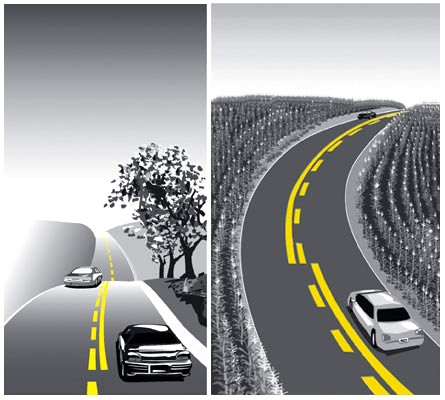
Yellow line markings, solid
If there is a single solid yellow line dividing lanes of traffic, you may not drive over this line to pass other vehicles. You may cross over a solid yellow line to make a left turn at an intersection, to enter or exit a road or a driveway, or to make a U-turn, if it can be made safely and is not otherwise prohibited.
On divided highways and some other roadways, a single solid yellow line will usually be used to indicate the leftmost boundary of the drivable roadway. You should not drive to the left of this line. Sets of solid yellow lines are frequently used to divide oncoming lanes of traffic before an upcoming hazard such as a road obstruction caused by the pillar of an over-crossing.
Yellow line markings, broken
If there is a single yellow line dividing lanes of traffic, and the line is broken (not continuous), you may pass over this to pass other vehicles, and to make left turns into other streets, driveways, and alleys if it can be done safely.
Yellow line markings, solid line next to a broken line
If there are two yellow lines dividing lanes of traffic, and the line closest to your lane is broken, you may cross over it to pass vehicles ahead, if it is safe to do so. If the line closest to your lane is solid, you may not cross over it except to turn left into a driveway or alley.
Yellow line markings, double solid lines
If there are two solid yellow lines dividing lanes of traffic, you may not cross over them to pass another vehicle. You should never drive to the left of these lines.
You may cross over a double solid yellow line to make a left turn at an intersection, to enter or exit a road or a driveway, or to make a U-turn, if it can be made safely and is not otherwise prohibited.
Two sets of solid double yellow lines that are two or more feet apart represent a wall or center divider. You may not drive on or over these lines for any reason. You may only make a U turn or left turn on a street divided with these lines at an opening provided for turns.
In some cases, one or more sets of parallel solid yellow lines are also used to separate carpool lanes from normal traffic lanes. Do not cross over these lines to enter or exit the carpool lane. Wait until the lines are broken or for some other designated place to enter or exit the lane. (Carpool lanes are discussed in more detail under white line markings.)
Yellow line markings, center left turn lanes
A center traffic lane enclosed by double yellow lines on each side with the inner lines broken may be used to start and complete left hand turns and start U-turns from either direction of traffic, but cannot be used for passing. The rules for proper use of center left turn lanes is frequently misunderstood by drivers.
You must use the center left turn lane to make a left turn or U turn if one exists on the street you are driving. You must signal and completely enter the lane before making your left-hand turn. Don't stop part way into the lane, with your vehicle blocking traffic.
You may only drive in this lane for a distance up to 200 feet, which is about the length of five or six vehicles. The limit on driving in a center left turn lane is to help prevent drivers from using this lane as a regular traffic lane or as a passing lane. You may not use a center left-turn lane for either of these purposes.
Be careful to look for vehicles coming from the opposite direction that are pulling into a center left turn lane. Because of the potential for meeting other vehicles coming from opposite direction head-on, center left turn lanes are often referred to as "suicide lanes."
When turning left from a side street or driveway, you have the option to use this lane before completing your turn. If you want to first turn into the center left-turn lane, you should signal, wait until it is safe, and then drive completely into the center left turn lane. Wait in the lane with your right-turn signal on for traffic to clear before pulling into traffic. Alternatively, if traffic is clear in both directions, you can just make your left turn directly from the side street or driveway, without first stopping in the center left turn lane.
You may drive across a center left turn lane to enter a driveway or street that is directly on the other side. However, you should not use a center left-turn lane to make a right turn.
Yellow line markings, school crossings
Broad yellow lines crossing the road are sometimes used to indicate a school crossing. Yellow markings on the pavement which say "SCHOOL XING" will usually also be painted near school crossings. You should carefully scan for children about to cross or crossing the road when you see these markings.
White line markings, general
White lines parallel to the roadway separate lanes of traffic going in the same direction, including bicycle lanes from car lanes. White lines which cross the roadway delineate crosswalks or limit lines. Messages such as "STOP AHEAD" or arrows directing traffic in a particular lane are often painted on the pavement in white. White lines of different configurations indicate different meanings.
White line markings, solid
A single or double solid white line dividing traffic lanes going in the same direction cannot be crossed for any reason.
On divided highways, a single solid white line will usually be used to indicate the rightmost boundary of the drivable roadway. You should not drive to the right of this line.
Sets of solid white lines are frequently used to divide the lanes before an upcoming hazard such as a road obstruction caused by the pillar of an over-crossing, or the median between a freeway off-ramp and normal traffic lanes. Again, these lines should not be crossed.
Thicker solid white lines are used to separate parts of left and right turn lanes close to the intersection. If you pass the part of the turn lane that has a broken white line or no line, you may not turn over the solid line to enter the turn lane.
White line markings, broken
If a single broken white line divides lanes of traffic, you may cross over the line to enter the lane next to you.
If the lane you are driving in has a thicker broken white line, then the lane you are in is for exiting the roadway, merging into other lanes, or is ending. The broken line will soon become a single solid white line or a set of double solid white lines which cannot be crossed.
White line markings, crosswalks
Crosswalks are delineated with sets of broad white lines which cross the road. However, crosswalks exist at most intersections where the roadways meet at approximately 90 degree angles and there is one or more sidewalks that would continue over the roadway, whether or not there are white painted lines. This is called an unmarked crosswalk. Crosswalks are often preceded by white words painted on the road indicating "SLOW PED XING."
There are special rules you must follow when dealing with pedestrians crossing the roadway, but in general you should always stop behind the crosswalk when you must stop at an intersection. (This is discussed in more detail in Unit 9.)
White line markings, limit lines
Thick solid white lines that cross the roadway are used to mark the limit line at intersections and the clearance line at RR crossings. You must stop behind these lines when you stop at an intersection or railroad crossing. The limit lines at railroad crossings are often preceded by white painted letters on the pavement such as "RXR."
White line markings, arrows
White arrows are sometimes painted on the roadway which indicate whether the lane proceeds ahead, merges, turns, or exits, and are intended to guide your choice of lane.
White line markings, words
Large white letters and symbols are often painted on the road to warn you of upcoming signals, stop signs, changes in the lane, bicycle lanes, and crosswalks. You should keep an eye on the roadway surface for these messages when you are driving.
White line markings, diamonds
Diamonds painted in a lane indicate that lane is for use by buses and carpools only. Using a carpool lane requires a minimum of 2 or 3 people in your vehicle (depending on what is indicated on the accompanying signs), including the driver.
Click on "Browser Back Button" to read next unit or to take a unit quiz.